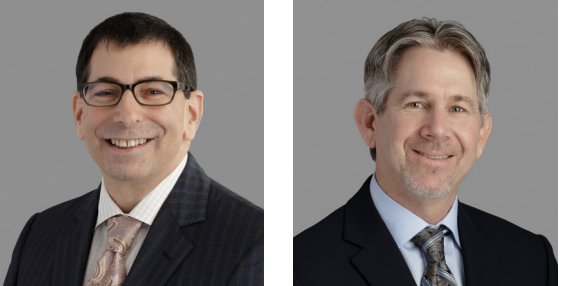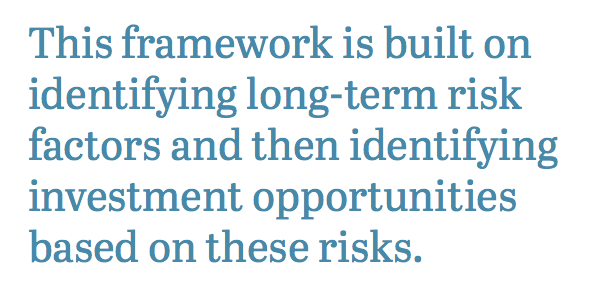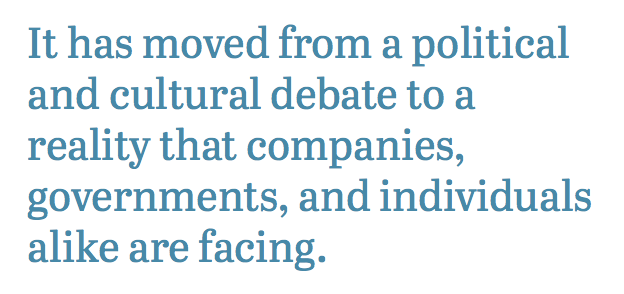 This quarter dives into the investment community’s increased focus on climate with Bailard’s Director of Sustainable, Responsible and Impact Investing Blaine Townsend, CIMA® and Chief Investment Officer, Eric P. Leve, CFA.
This quarter dives into the investment community’s increased focus on climate with Bailard’s Director of Sustainable, Responsible and Impact Investing Blaine Townsend, CIMA® and Chief Investment Officer, Eric P. Leve, CFA.
September 30, 2021
Eric P. Leve, CFA: You’ve been in the ESG business since the 1990s Blaine, what’s your perspective on the increased interest from investors?
Blaine Townsend, CIMA®: ESG investing has been around as a truly professional investment offering for 50 years, but in the past 18 months we’ve seen a total capitulation in the market. I think it was a collision of long-held and hard-fought wins by the ESG (environmental, social, and governance) and socially-responsible investing (SRI) community validated by external factors too hard to ignore; I’ll name climate risk, gender and ethnic inequality, and poor corporate governance for just a few. There has come a maturation of thinking, and a recognition that balancing social well-being and economic growth should not be seen as mutually exclusive.
Eric: Let’s spend some time with the first factor you just mentioned. Where does climate rank amongst the ESG factors investors should consider?
Blaine: It is at the top of the list. It has the potential to totally transform markets over the next 10 or 20 years and long-term investors must understand the level of climate risk in their portfolios.
If you’ll give me a moment to elaborate, forward-looking ESG analysis works to assess the materiality of nontraditional data and determine which companies are best prepared to compete in the world ahead. This framework is built on identifying long-term risk factors and then identifying investment opportunities based on these risks.
With respect to climate, scrutiny around the potential long-term risks here has been building like steam in a kettle for some time. Climate scientists were concerned by what their models were showing as early as the 1980s, yet public debate has raged in the decades since.
Eric: So tell me then, why climate now? Is this just a question of stranded assets and exposure to oil and gas majors? Or are there other implications?
Blaine: The growing focus on limiting climate change is expected to decrease demand for coal, oil, and gas, as well as the infrastructure required to get them out of the ground. This can then turn these commodities into “stranded assets” that will never be fully utilized. The stranded assets argument is a good starting point, because all that’s required for that thesis to play out is for regulators around the world to make it harder and more expensive to take carbon out of the ground. That is already happening. The stage is set for further transformation.
2021 has certainly seen growing support for “Net Zero” commitments being made by countries, municipalities, and companies around the world to counterbalance the emissions released with those removed by 2050. To paraphrase the words of the United Nations, for a livable world, these Net Zero commitments must be backed by true action. If market participants genuinely commit to Net Zero and work to limit the rise in global emissions to 1.5 degrees Celsius by 2050, the markets can’t help but be reshaped in 20 years. Energy transition and decarbonization will become massive drivers of capital investment and will reshape the market. For example, there will be entire new segments of the market focusing on transitional energy and carbon sequestration. Net Zero cannot happen any other way.
Eric: Clearly, this could be transformational. So Blaine, tell me what you see next on the horizon.

Blaine: There are solutions that are market ready but not deployed. For example, don’t be surprised if we soon see vertical farming or mandates on buildings to sequester carbon. There will be entire value chains created to support these industries. There will be new tools designed to measure and improve efficiency in business, in the home, and within transportation. Consider that the electric vehicle revolution hasn’t even really started yet. We really don’t even have widespread charging stations and, there’s many yet-to-be built businesses and processes there. Consumer products and consumer behavior will be reshaped by this transition. The industry sectors and market leaders 20 years from now may look nothing like they do today… much like the leadership of the Dow Jones Index has changed so dramatically over the past half a century.
Eric: How is the investing community impacted by the regulatory backdrop on climate?
Blaine: For many of the most important climate related disclosures, the framework is still evolving. The Securities and Exchange Commission (SEC) recognized climate change in 2010 as a material risk that should be disclosed, but the regulators are just now moving toward substantial change. It is a tricky situation because we remain stuck in an era of voluntary reporting on many crucial climate-related issues that are financially material to investors – and the clock is running.
For example, take what are called Scope 3 emissions. These are the emissions related to the entire value chain of a product or service and make up the lion’s share of a company’s emissions. From some oil majors, for example, Scope 3 emissions account for 90% of their total emissions. Very few companies have pledged to disclose their Scope 3 emissions, much less reduce them. And, as I said, if they do disclose them, it is purely voluntary. The good news is that, by and large, the market players want the regulatory regimes to make disclosure mandatory. There is evidence of this in every major jurisdiction around the world. Investors want to know which companies are reporting their emissions, and which aren’t.
The SEC’s comments I mentioned reflect a long and sustained movement by responsible investors who maintain that environmental, social, and governance issues are material to the long-term performance of a stock. By contrast, Wall Street has only recently turned its considerable intellect to this type of analysis, but the shift is gaining momentum. I firmly believe climate will be the single-biggest influence on investment performance out of any other factor over the next 25 to 30 years. It has moved from a political and cultural debate to a reality that companies, governments, and individuals alike are facing.

The fact that non-traditional risk factors like climate change have become widely accepted as real risks to financial and business returns makes sense. It is based on empirical observation, not emotional reaction.
Eric: This makes for a strong argument that the tides have turned. We are seeing the confluence of a growing body of data from companies, increasing investor interest, and a global recognition of the need to address our long-term risks. Thanks, as always, Blaine for leading the charge.
Recent Insights
Country Indices Flash Report – April 2025
U.S. policy and global equities swung wildly during the month as ‘Liberation Day’ was followed by a 90-day pause in many tariffs and the administration’s harsh tone toward Fed Chair Jerome Powell softened. These America-centered policy shocks led to broad dollar weakness: the euro and pound reached three-year highs. EAFE had declined more than 10% before fully recovering, ending April in positive territory.
April 30, 2025
Quarterly International Equity Strategy Q1 2025
Non-US assets found renewed vigor to begin 2025, in sharp contrast to late 2024. Echoing the first Trump administration eight years ago, U.S. policy uncertainty weighed on the dollar and U.S. equities, while stimulus and reform improved sentiment elsewhere (the Eurozone in particular). The resulting spread of MSCI EAFE over MSCI USA was the widest first-quarter return differential since 1986. While reduced policy visibility may dampen real investment and activity across many countries and industries in the short-term, we believe recent volatility may provoke broader re-examination of allocation to non-US equities, and a constructive starting point for longer-term performance.
April 28, 2025
Quarterly Technology Equity Strategy Q1 2025
The Bailard Technology Strategy posted a 1Q25 total return of -9.35% net of fees—ahead of both the benchmark index (S&P North American Technology Index) and the competitor-comprised benchmarks. The Morningstar U.S. Open End Technology Category returned -9.98% and the Lipper Science and Technology Fund Index returned -10.88%, while the S&P North American Technology Index returned -11.43%. Over longer time periods of 3, 5, and 10 years, the Strategy’s net returns continued to lead the competitor’s peer benchmarks—quite substantially, as seen in the table to the right.
Despite market volatility in Q1, we have not significantly altered our positioning. Our view is that nothing is broken in tech, and we remain convicted in our investment process. With prices and valuation changing dramatically, we expect to optimize our positioning by bolstering or adding high-quality companies trading at attractive discounts to long-term value. We anticipate stabilization in industry fundamentals and fiscal policy in the latter part of this year.
April 16, 2025
Keep Informed
Get the latest News & Insights from the Bailard team delivered to your inbox.